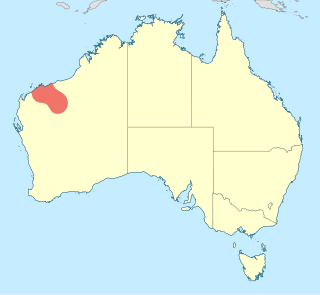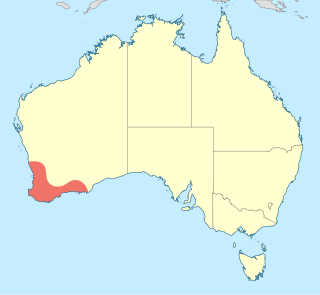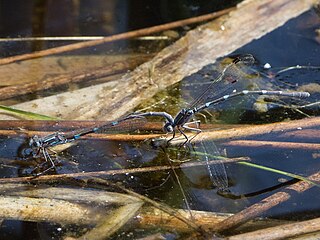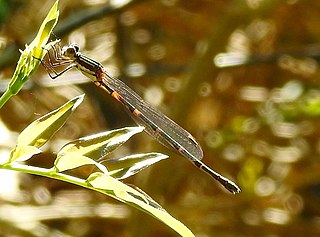
Agriocnemis femina, the variable wisp or pinhead wisp, is a species of damselfly in the family Coenagrionidae. It is a small damselfly; mature males have a white pruinescence over their body, and a dark tail. It is found from India, through South-east Asia to islands in the Pacific. where it inhabits pools and stagnant water.

Agriocnemis pygmaea is a species of damselfly in the family Coenagrionidae. It is also known as wandering midget, pygmy dartlet or wandering wisp. It is well distributed across Asia and parts of Australia.

Gynacantha dobsoni is a species of dragonfly in the family Aeshnidae, known as the lesser duskhawker. It inhabits ponds and swamps and is found in northern Australia.

Ictinogomphus dobsoni is a species of dragonfly in the family Lindeniidae which was formerly part of the family Gomphidae, and known as the Pilbara tiger. It is a medium to large, black dragonfly with yellow markings and clear wings. Ictinogomphus dobsoni is endemic to the Pilbara region in Western Australia, where it inhabits rivers, lakes and ponds.

Agriocnemis argentea is a species of damselfly in the family Coenagrionidae, commonly known as a silver wisp. It is a small damselfly; the male, when mature, is covered in a white pruinescence. It is endemic to northern Australia where it inhabits both still and flowing waters.

Agriocnemis rubricauda is a species of Australian damselfly in the family Coenagrionidae, commonly known as a red-rumped wisp. It is a small damselfly; the male has a red end to his tail. It has been recorded from northern Australia where it inhabits boggy seepages and swamps.

Agriocnemis kunjina is a species of Australian damselfly in the family Coenagrionidae, commonly known as a Pilbara wisp. It is a small damselfly, endemic to the Pilbara region in Western Australia, where it inhabits still and flowing water.

Archibasis mimetes is a species of damselfly in the family Coenagrionidae, commonly known as a blue-banded longtail. It is a medium-sized damselfly; the male is bright blue and black. It has been recorded from New Guinea and northern Australia, where it inhabits streams.

Neosticta fraseri is a species of damselfly in the family Isostictidae, commonly known as a tropical pinfly. It can be found in tropical north-eastern Queensland, Australia, where it inhabits streams.

Austrolestes aleison is an Australian species of damselfly in the family Lestidae, commonly known as a western ringtail. It is endemic to south-western Australia, where it inhabits pools, ponds and lakes.

Austrolestes aridus is an Australian species of damselfly in the family Lestidae, commonly known as an inland ringtail. It is widespread across inland Australia, where it inhabits streams, pools, and ponds.

Austrolestes minjerriba is an Australian species of damselfly in the family Lestidae, commonly known as a dune ringtail. It is found in coastal areas of northern New South Wales and southern Queensland where it inhabits acidic dune lakes and swamps.

Austrolestes io is an Australian species of damselfly in the family Lestidae, commonly known as an iota ringtail. It has been found in both south-western Australia as well as south-eastern Australia where it inhabits pools, lakes and ponds.

Austrolestes leda is an Australian species of damselfly in the family Lestidae, commonly known as a wandering ringtail. It is found across eastern Australia where it inhabits slow and still water.

Lestoidea barbarae is a species of Australian damselfly in the family Lestoideidae, commonly known as a large bluestreak. It has only been recorded from the vicinity of Wooroonooran National Park, in north-east Queensland, where it inhabits streams in rainforest.

Archiargiolestes pusillus is a species of Australian damselfly in the family Megapodagrionidae, commonly known as a little flatwing. It is endemic to south-western Australia, where it inhabits streams, bogs and swamps.

Austroargiolestes calcaris is a species of Australian damselfly in the family Megapodagrionidae, commonly known as a powdered flatwing. It is endemic to south-eastern Australia, where it inhabits streams, deep pools and bogs, generally in mountainous areas.

Nososticta koolpinyah is a species of Australian damselfly in the family Platycnemididae, commonly known as a Koolpinyah threadtail. It has only been found in the vicinity of Darwin and on Melville Island in Northern Territory, where it inhabits streams.

Nososticta koongarra is a species of Australian damselfly in the family Platycnemididae, commonly known as a citrine threadtail. It has only been found on the Arnhem Land escarpment in Northern Territory, where it inhabits streams.

Nososticta taracumbi is a species of Australian damselfly in the family Platycnemididae, commonly known as a Melville Island threadtail. It is endemic to Melville Island, Northern Territory, where it inhabits streams.























